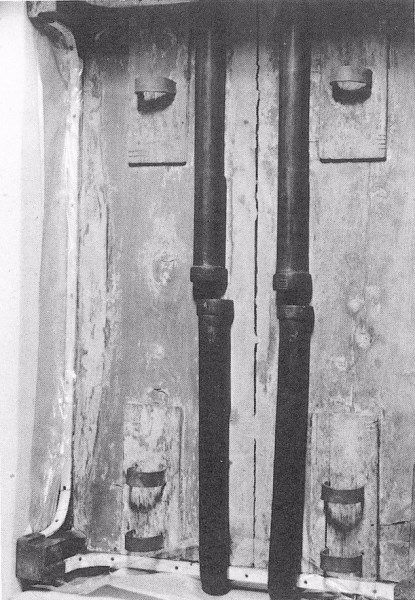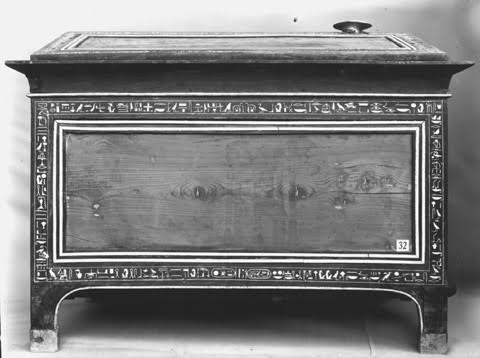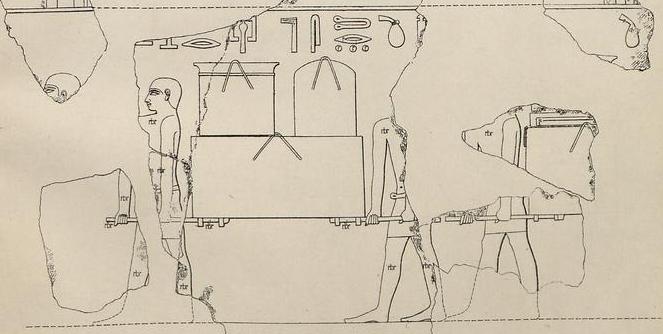 Edit article
Edit articleSeries
The Poles of the Ark and Tutankhamun’s Chest

Figure 1. Red chest from the tomb of Tutankhamun, equipped with carrying poles, shown with poles extended. Burton photograph 1557. From Malek, Tutankhamun.
Exodus 25 presents a detailed formal description of the tabernacle and its contents. The first item described is the “ark of the testimony” (אֲרוֹן הָעֵדוּת; vv. 10–16), which is regarded throughout the Bible (by a variety of names) as the central object in any legitimate Israelite worship.[1]
Permanent Carrying Poles
The ark is designed to be carried by poles. The text specifies that these are to be inserted into four gold rings at each of the ark’s four feet (vv. 12–14); it adds that the poles should always stay in the ark’s rings (v. 15):
שמות כה:טו בְּטַבְּעֹת הָאָרֹן יִהְיוּ הַבַּדִּים לֹא יָסֻרוּ מִמֶּנּוּ.
Exod 25:15 The poles shall remain in the rings of the ark: they shall not be removed from it (NJPS).
This is consistent with the description of the Solomonic Temple in 1 Kings 8:7–8 (=2 Chron. 5:8–9):
מלכים א ח:ח וַיַּאֲרִכוּ הַבַּדִּים וַיֵּרָאוּ רָאשֵׁי הַבַּדִּים מִן הַקֹּדֶשׁ עַל פְּנֵי הַדְּבִיר וְלֹא יֵרָאוּ הַחוּצָה וַיִּהְיוּ שָׁם עַד הַיּוֹם הַזֶּה.
1 Kgs 8:8 The poles projected so that the ends of the poles were visible in the sanctuary in front of the Shrine, but they could not be seen outside; and there they remain to this day.
The table (25:26-27), the bronze altar (27:4, 7), and the incense altar (30:4-5) are also described as having rings for poles when they are carried, but the text does not say that the poles should stay in those rings permanently.
Carrying Poles That Can Be Inserted When Needed
Numbers 4, however, as part of the instructions regarding the preparation of the tabernacle for transport from place to place in the wilderness, states that in the course of preparing the ark for carriage, its carrying poles should be inserted by Aaron and his sons (v. 6):
…וְשָׂמוּ בַּדָּיו.
…and they shall put its poles in place.
But if the poles of the ark are always “in,” how can they be “put in” when preparing the ark for transport?[2] This contradiction so bothered some medieval commentators, that they felt forced to explain one or the other verse against its simple meaning.
Abraham Ibn Ezra (1089-1167)
ושמו בדיו – והנה יסירום עד שיכסו את הארון.
“Place its poles” – for they would need to remove them temporarily when they covered the ark.
ויש אומ[רים]: ושמו בדיו – על כתפות הנושאים.
Alternatively, “place its poles” – on the shoulders of the carriers.
Hizkuni (Hezekiah ben Manoah, 13th cent.)
ושמו בדיו – ומה שנאמר לא יסורו ממנו, ארבעה בדים היו שנים קבועים בו ועליהם נאמר לא יסורו ממנו ועל השנים אחרים הוא אומר ושמו את בדיו.
“Place its poles” – and regarding that which it says “do not remove them,” there were four poles. Two of them were attached permanently to it, and regarding these it says “do not remove them.” The two others are the ones about which it says “place its poles.”[3]
Each of these solutions runs counter to the simple meaning of one of the verses or invents new facts.
Two Priestly Texts?
Some modern scholars have addressed the contradiction by contending that the two verses belong to different strata of priestly writings.[4] (Both Exod. 25:15 and Num. 4:6 belong to the Priestly source.) But even if we accept this proposition, the difficulty is not lessened. The tabernacle pericopae as a whole display remarkable consistency; whoever authored the later stratum, if there was one, made an effort to avoid contradictions in other places with the earlier stratum—so why would he have allowed a contradiction here?
“Set Up” not “Insert”
The verb וְשָׂמוּ in Num 4:6, 8, 11, and 14 is typically understood in the sense of “put in”—this indeed is the origin of the contradiction between Exodus and Numbers. But this sense of the verb requires the indirect object (e.g., *וְשָׂמוּ עָלָיו בַּדָּיו), which is absent here. Every other time the verb שִׂים appears in the tabernacle pericopae without an indirect object, it conveys the broader sense of “set up” rather than “insert.” These occurrences are all in Exod 40:
- וְשַׂמְתָּ אֶת הֶחָצֵר סָבִיב (“set up the enclosure round about,” v. 8);[5]
- וַיָּשֶׂם אֶת קְרָשָׁיו (“setting up its planks,” v. 18);
- וַיָּשֶׂם אֵת פָּרֹכֶת הַמָּסָך (“he set up the curtain for screening,” v. 21).[6]
These data suggest that the four occurrences of וְשָׂמוּ בַּדָּיו in Num 4 do not mean “and they shall insert its poles” but rather “and they shall set up its poles.”[7] In other words, Aaron and his sons should perform whatever actions are necessary so that the poles of each object are in the proper position for their use, i.e., for transporting the objects, just as in Exodus 40 Moses is to perform whatever actions are required for the various parts of the tabernacle to be in the proper position for their use, i.e. for enshrining the divine presence.
Num. 4 does not imply that the precise physical operations involved in “setting up” the poles is identical in all cases.[8] The poles of the table and the altars might very well need to be inserted into their rings, while “setting up” those of the ark might only involve positioning them correctly within the rings.
Indeed, a general solution along these lines is what was envisioned by many of the medieval commentators.[9] Of greatest interest to us are two comments, neither of them entirely clear.
R. Eliakim b. Meshullam of Speyer (11th cent)
.ואין נשמטין לגמרי בין הטבעות אלא נמשכין ויוצאין חוץ בטבעות אבל מכל מקום היו קבועין בארון כעין בריחי דלתות שלנו שקבועין בכותל
They are not removed entirely from between the rings, rather they are extended through the rings, but, nevertheless, they remain attached to the ark, similar to our door hinges which are attached to the wall.
Ramban (R. Moses ben Nahman, 1194-1270)
והנכון כי “ושמו” שיתקנו אותם להיות יוצאים לשאת אותו בהם כי היו הטבעות רחבים ויאריכו הבדים בהם כרצונם ובלבד שלא יסורו ממנו.
The correct interpretation of ושמו is that they should be adjusted to protrude so that it can be carried, for the rings were wide and the poles could be extended (alluding to 1 Kings 8:8) as much as was wanted, as long as they were not removed entirely.
What precise mechanism might the priestly writer have had in mind, though? Here archeological evidence that the medievalists did not have offers the key.
Portable Egyptian Chests
The ark is a portable wooden chest made in typical Egyptian style, and extant chests from the ancient Near East, particularly Egypt, reveal parallels to almost every detail of the ark as described in priestly and other biblical texts.[10] Indeed, a gable-lidded chest found in the tomb of the fourteenth century Pharaoh Tutankhamun [See Figure 1 above] is equipped with carrying poles.[11]

This chest exhibits general similarities to the ark as described in the priestly account:
- Dimensions – All three of its dimensions are based on the cubit and its width equals its height, as is the case with the ark (Exod 25:10 = 37:1).[12]
- Zer – The chest is also crowned with a cavetto cornice, a feature that I have identified with the זֵר that adorns the ark in the priestly account (Exod 25:11 = 37:2).[13]
- Wood – Like the ark, the chest is made of wood (cf. Exod 25:10 = 37:1; also Deut 10:1, 3).
- Four Poles – A British Museum catalogue entry on the chest displays a photograph of its poles [Figure 2] and includes the following description:
Unlike the other chests found in the tomb this chest, no doubt because of its size and weight when full, was provided with four poles so that it could be carried by bearers on their shoulders. Each pole slides backwards and forwards through two bronze rings, attached to boards which are fixed at the bottom of the box. A collar at the back end of the pole, greater in circumference than the ring, prevents the pole from slipping forward through the inner ring.[14]
How Many Poles on the Ark?
The priestly account has usually been understood to mean that the ark had two poles, each of which was fitted through two rings at different corners and was long enough to protrude both in front of the ark and in back. However, neither this account nor any other text in the Bible actually states how many poles the ark (or the table and altars) had.[15]
In light of the meticulous and number-loving character of the tabernacle pericopae, the absence is understandable only if the priestly author assumed that the number of poles would be obvious to the reader. The fact that in his account the golden altar has poles (in the general plural), though it only has two rings (Exod 30:4–5 = 37:27–28), reveals that he envisioned – and expected the reader to envision – that each pole is held by only one ring. This indicates that the priestly author, who gave the ark four rings, meant to portray it as having four poles, like the Tutankhamun chest.[16]
Comparing Poles: Bible and Tutankhamun
The photograph and description express several other details of similarity between the poles of the Tutankhamun chest and the poles of the ark as described in Exodus:
- They are made of wood (cf. Exod 25:13 = 37:4);
- They are slid through metal rings near each of the chest’s four feet (cf. 25:12 = 37:3);
- They are aligned along the chest’s long sides (cf. 25:14 = 37:5).
- They are also fashioned and positioned in a way that would make it difficult to slide them out of the rings and remove them entirely from the chest (cf. Exod 25:15).
Egyptian Style Retractable Poles
Most significantly for our discussion, the carrying poles of the Tutankhamun chest are retractable: “When the chest was not being carried, the poles could be pushed back until the collars of two axially opposite poles were touching each other and the poles were then entirely concealed from view.”[17] In other words, the poles could be slid under the chest, in the space between its underside and the bottoms of its feet, while still held by the metal rings [Figure 3 a & b]. When the chest was to be carried, the poles could be drawn out again in preparation, still held by the rings.


This is not an innovation of the New Kingdom. Some earlier depictions of chests equipped with carrying poles from Old Kingdom Egypt show poles that slid through rings like those of the Tutankhamun chest [Figure 4], demonstrating, in the judgment of Geoffrey Killen, that the poles were designed to slide underneath the chests in the same manner.[18]
If carrying poles on ancient Egyptian-type chests were normally retractable,[19] or at least if this was the practice with which the author of Num 4:6 was acquainted, then both he and his audience would most naturally expect that the ark’s permanent poles would need to be “set up” in preparation for transport: i.e., they would still need to be drawn out from underneath it so that they could be grasped by its porters.

Why Just the Ark?
The requirement that the carrying poles remain affixed applies to the ark, but not to the table and the altars[20] because chests’ feet create a low, narrow space between their lower surface and the ground and therefore, the carrying poles can be hidden from sight. Thus, only in the case of the ark would such a requirement be compatible with the goal of an aesthetic tabernacle. The carrying poles of the table and altars would presumably need to be removed and stowed elsewhere.
The Ark in Its ANE Context
The observation that the biblical ark is described as a portable wooden chest, aided by an investigation of actual and depicted objects of that type from the ancient Near East, can help solve a seeming contradiction in the biblical text. It also adds an important element to the image of the ark that the priestly writer apparently intended to convey, one which those familiar with ancient Near Eastern crafts would have understood unaided.
TheTorah.com is a 501(c)(3) nonprofit organization.
We rely on the support of readers like you. Please support us.
Published
February 27, 2016
|
Last Updated
November 7, 2025
Previous in the Series
Next in the Series
Before you continue...
Thank you to all our readers who offered their year-end support.
Please help TheTorah.com get off to a strong start in 2025.
Footnotes

Prof. Raanan Eichler is an Associate Professor of Bible at Bar-Ilan University in Israel. He received his Ph.D. from the Hebrew University of Jerusalem and completed fellowships at Harvard University and Tel Aviv University. He is the author of The Ark and the Cherubim (Mohr Siebeck, 2021) and many academic articles.
Essays on Related Topics:









